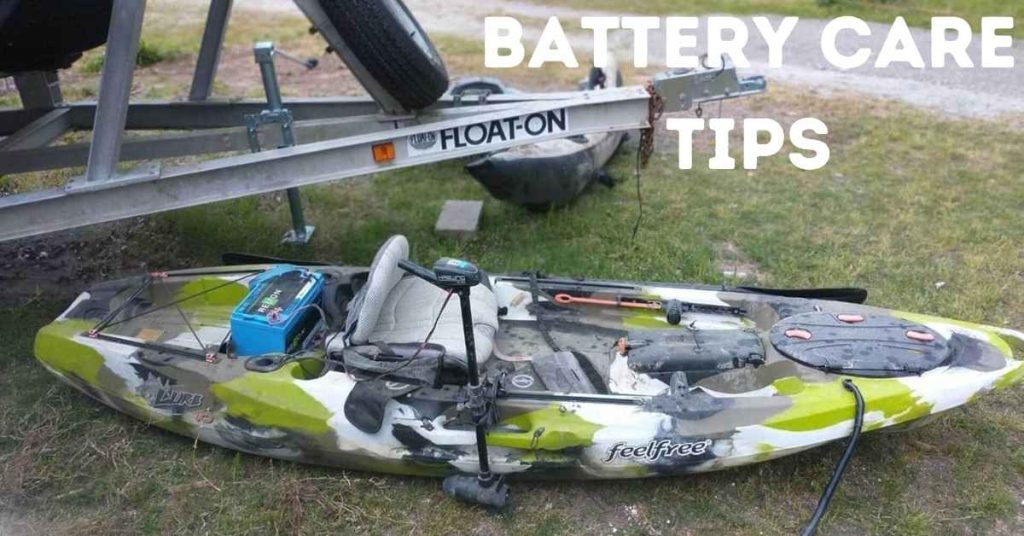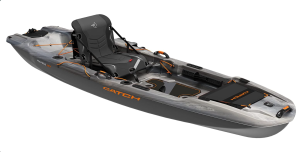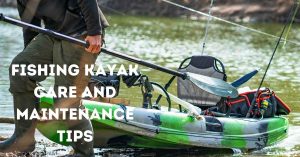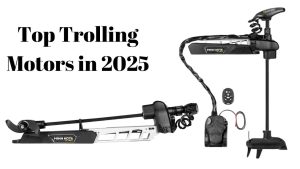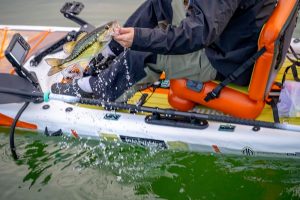Having a motorized kayak is exciting. It lets you easily explore waterways. But, keeping your kayak’s battery healthy is key for a good ride. In this guide, we’ll share important tips to keep your kayak running smoothly.
Key Takeaways
- Understand the different types of kayak motor batteries, including lithium-ion and lead-acid, and their unique care requirements.
- Learn proper charging techniques and best practices to maximize battery performance and lifespan.
- Discover effective storage guidelines for your kayak battery during the off-season.
- Implement regular maintenance strategies to keep your battery in optimal condition.
- Familiarize yourself with safety precautions when handling and transporting your kayak battery.
Understanding Different Types of Kayak Motor Batteries
Choosing the right battery for your motorized kayak is key to a great experience. You have two main options: lithium-ion and lead-acid. Knowing the good and bad of each can help you pick the best one for you.
Lithium-ion vs. Lead-Acid Batteries
Lithium-ion batteries are top-notch for trolling motor battery care. They’re light, last long, and give steady power. Lead-acid batteries are cheaper but heavier and don’t last as long.

Power Requirements for Different Motor Types
The power your kayak motor needs depends on its size and use. Smaller motors might need less lithium-ion battery maintenance. But bigger motors need more power to run well. Think about your motor’s needs when picking a battery.
Battery Capacity and Performance Metrics
When looking at battery performance metrics, amperage-hours (Ah), watt-hours (Wh), and runtime are key. These tell you how much power the battery has and how long it lasts. Knowing these helps you find the right battery for your needs.
“Choosing the right battery for your motorized kayak can make all the difference in your on-water experience. Careful consideration of the battery type, power needs, and performance metrics will ensure you get the most from your investment.”
Essential Battery Care Tips for Motorized Kayaks: What You Need to Know
Keeping your motorized kayak’s battery healthy is key for a great time on the water. This section will share important tips for battery care tips for motorized kayaks and extending battery life. You’ll learn how to keep your kayak’s power source in top shape.
Cleaning the battery terminals and connections regularly is a must. Over time, corrosion can build up, hurting the battery’s performance. Use a wire brush or battery terminal cleaner to clear out any corrosion, ensuring a good connection.
Also, watch your battery’s performance closely. Look out for signs like slower charging or quicker discharge. Catching these issues early can help you take steps to extend battery life.
“Proactive battery care is the key to maximizing the lifespan of your motorized kayak’s power source.”
Finally, think about how you store your kayak when it’s not in use. Storing it right, like keeping it at the right temperature and charge, helps a lot. This is a big part of battery care tips for motorized kayaks.
Proper Charging Techniques and Best Practices
Keeping your motorized kayak’s battery healthy is key for good performance and long life. The right charging methods and practices are very important. We’ll look at the best temperatures for charging, how often to charge, and the need for the right equipment.
Optimal Charging Temperature Ranges
Charging your battery is very sensitive to temperature. For the best results, keep the temperature between 50°F and 80°F (10°C and 27°C). Charging in very hot or cold temperatures can harm your battery and be unsafe.
Charging Schedule Guidelines
Having a regular charging schedule is vital. Don’t wait until the battery is completely empty before charging. Charge it when it’s at 20-30% instead. This prevents damage and keeps the battery lasting longer. Also, charge it right after each use to avoid long periods of being empty.
Equipment and Charger Specifications
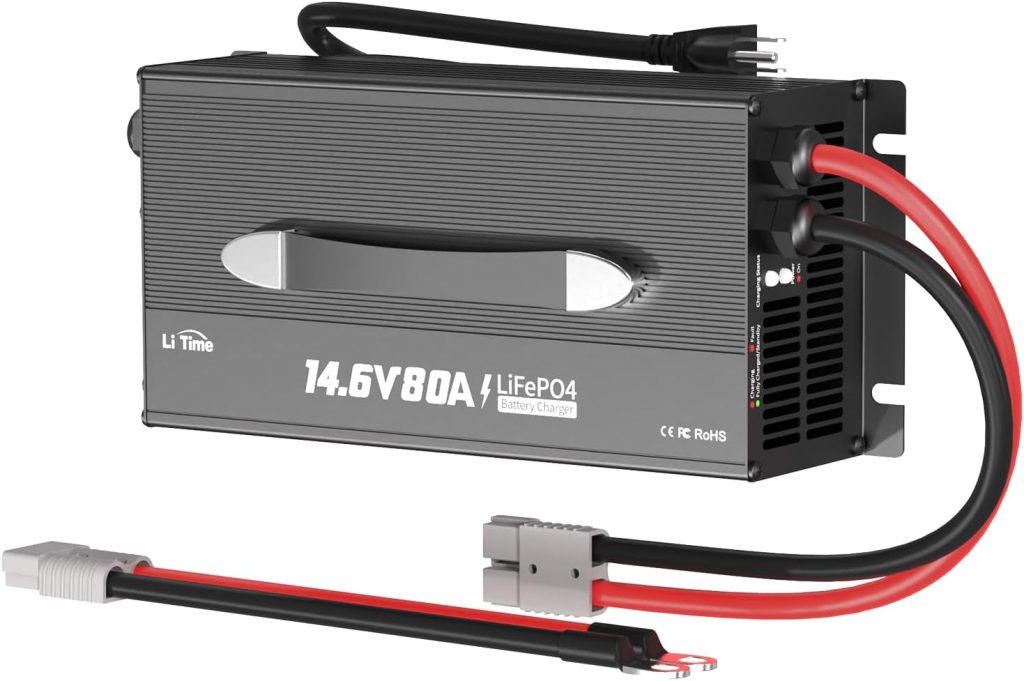
LiTime 80-Amp Lithium Battery Charger
It’s important to use the correct equipment and chargers for your battery. Check what your manufacturer suggests and make sure the charger fits your battery type, like lithium-ion or lead-acid. The wrong charger can cause harm or be dangerous, so always use the recommended one.
“Proper battery charging techniques and best practices are essential for maintaining the performance and longevity of your motorized kayak’s power source.”
By sticking to these battery charging best practices, keeping the optimal charging temperature, and following a regular charging schedule, your motorized kayak’s battery will work well and last a long time.
Battery Storage Guidelines During Off-Season
When the kayaking season ends, it’s crucial to store your motorized kayak’s battery right. Following battery storage guidelines and off-season battery care helps keep your kayak motor in top shape. This way, you can enjoy it for many seasons to come.
The best storage temperature for your kayak battery is between 40°F and 80°F. Extreme temperatures can harm your battery’s health and performance. Make sure the storage area is cool, dry, and has good air flow.
Before you store the battery, charge it to about 50% of its full capacity. This keeps the battery’s chemical balance right and prevents it from losing charge too much. Don’t store it fully charged or completely drained, as this can shorten its life.
Check on the battery often while it’s in storage. Consider using a trickle charger or smart charger to keep it at the best charge level. This simple care can greatly help keep your battery healthy and ready for your next adventure.
Maximizing Battery Life Through Regular Maintenance
Keeping your motorized kayak’s battery in good shape is key to its long life and best performance. Simple maintenance steps can greatly improve your battery’s life. This includes cleaning connections and watching how it performs. We’ll show you how to get the most out of your battery.
Cleaning and Connection Maintenance
Keeping your battery’s connections clean is a simple but effective way to extend its life. Check the terminals and connectors often for corrosion or buildup. Use a wire brush or battery terminal cleaner to clean them off. This ensures a strong connection, which is vital for your battery’s health.
Performance Monitoring Tips
Watching your battery’s performance closely can give you important information about its health. Pay attention to its voltage, charge level, and how long it lasts. If you see any big changes or a drop in performance, it might be time to check or replace your battery.
Warning Signs of Battery Issues
Knowing the signs of battery problems can help you fix them before they get worse. Look out for swelling, leakage, or too much heat, as these are warning signs. Also, if your battery charges slower or doesn’t hold a charge like it used to, it might need to be replaced.
By following these regular maintenance practices, you can extend the life of your motorized kayak’s battery and enjoy reliable, long-lasting performance on the water.
Safety Precautions When Handling Kayak Batteries
When you’re using a motorized kayak, keeping your battery safety precautions in check is key. It’s vital to handle your battery safely to avoid accidents and keep you and your kayak safe. Here are the essential safety tips to remember when dealing with your kayak battery.
Always wear gloves and goggles when handling your battery. Batteries are heavy, and the chemicals inside can be harmful if they touch your skin or eyes. Also, watch out for any cracks or leaks in the battery casing. These can be a big battery safety risk.
“Prioritizing battery safety precautions is crucial for a safe and enjoyable kayaking experience.”
Another key safe battery handling tip is to stay away from sparks or open flames near the battery. Batteries can release flammable gases, and a spark could start a fire. Make sure the area is well-ventilated and free of any fire hazards when charging or storing your battery.
Remember, taking care of your kayak battery safety is not just about protecting yourself. It’s also about looking after your investment. Treat your battery with care, and it will give you reliable performance and last longer.
Waterproofing and Protection Measures
Keeping your motorized kayak’s battery safe from the elements is key. Moisture is the biggest threat, so it’s important to act fast. You can waterproof the battery area and protect it when moving to keep your kayak’s batteries working well.
Moisture Prevention Techniques
Waterproofing the battery area is a great first step. Use waterproof enclosures or sealants made for the sea. Check the area often for cracks or gaps and seal them up to keep it dry.
Also, think about using desiccant packs in the battery area. These small packets soak up humidity, helping to keep your waterproofing kayak batteries safe.
Protection During Transport
When you move your kayak, make sure the batteries are secure. Use straps or clamps to keep them still. A protective case or box can also shield them from moisture prevention and bumps.
By protecting your batteries during transport, you keep your kayak’s power source safe. This way, it’s always ready for you.
Troubleshooting Common Battery Problems
If you love motorized kayaking, you might face battery troubleshooting issues. Knowing how to fix common battery issues ensures your kayak battery works well. Here are some tips to keep your kayak motor running smoothly.
One big problem is when your battery doesn’t last as long. This could be from overcharging, extreme temperatures, or just getting old. Watch how your battery does and follow the right charging and storage tips to make it last longer.
Another issue is when your battery doesn’t perform consistently. If your motor weakens or acts strangely, it might be the battery. This could be from loose connections, damage inside, or not matching your kayak’s system. Check your battery connections often to avoid these problems.
Charging issues can be really annoying. If your battery won’t charge right, look at the charger and port for damage or blockages. Make sure you’re using the right charger for your battery and keep the charging area at the right temperature.
Fixing these common battery issues quickly helps your motorized kayak run smoothly. Regular care and quick troubleshooting are essential for a great on-the-water experience. Keep your kayak battery in top shape with these tips.
Battery Replacement and Upgrade Considerations
As your motorized kayak’s battery gets older or your needs change, you might need to replace or upgrade it. Knowing when and how to choose the right replacement is key to a great experience on the water.
When to Replace Your Battery
You might need a new battery if your kayak’s motor doesn’t perform as well as it used to. Look out for signs like shorter runtime, longer charging times, or trouble holding a charge. If your battery is over 2-3 years old, it’s time to think about getting a new one. Even with good care, batteries lose power and efficiency over time.
Choosing the Right Replacement
When picking a new battery, think about your kayak’s make and model, the motor’s power needs, and how you use it. Talk to the manufacturer or a trusted dealer to find a battery that fits your kayak’s electrical system and meets your power needs. Also, look into different types of batteries, like lithium-ion or lead-acid, to see which is best for you.
FAQ
What are the different types of batteries used in motorized kayaks?
Motorized kayaks use two main battery types: lithium-ion and lead-acid. Lithium-ion batteries are light, rechargeable, and pack a lot of energy. Lead-acid batteries are cheaper but heavier.
How do I properly charge my kayak’s battery?
To charge your kayak’s battery right, keep the temperature between 50°F and 80°F. Follow the charging schedule from the maker. Use the right charger to avoid battery damage.
How should I store my kayak’s battery during the off-season?
Store your kayak’s battery at 50% charge in a cool, dry spot. Keep it between 40°F and 80°F. Avoid extreme temperatures and humidity to keep the battery lasting longer.
What are some essential battery maintenance tips for motorized kayaks?
Key maintenance tips include cleaning battery connections and watching battery performance. Also, fix any warning signs early. Proper handling and waterproofing help extend battery life.
How do I know when it’s time to replace my kayak’s battery?
Replace your kayak’s battery if runtime drops a lot, performance is uneven, or it’s over 2-3 years old. Make sure the new one fits your kayak’s motor and power needs.
What safety precautions should I take when handling my kayak’s battery?
When handling your kayak’s battery, wear gloves and avoid short circuits. Keep it away from heat and dispose of old batteries correctly.

